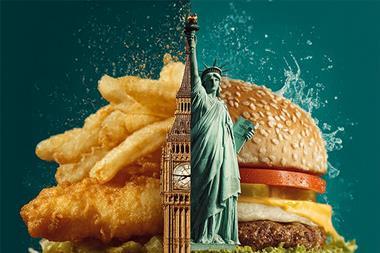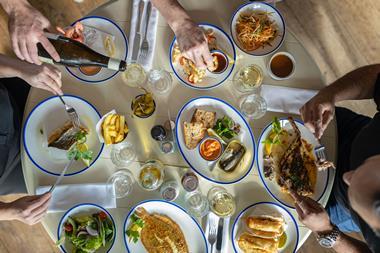Eating out is a real social experience. It’s about being with people, whether they are family, friends or colleagues - you visit a restaurant or pub to be with people you actually want or need to spend time with. The best experience delivers so much more than food. Hopefully, the food is the highpoint of the experience. However, whatever time of day we choose to dine, as consumers, we head out expecting so much more than just food, says Tom Weaver, chief executive and co-founder of Flypay.
An experience can be tarnished by the little things – cold food, orders arriving at vastly different times, or indeed not at all. Most restaurant innovation is focused on solving these little pain points, from capacity management to ordering systems, all with the aim of taking the hassle out of eating out.
The restaurant experience sees innovations at several levels. An experience is fundamentally a piece of theatre. The biggest and most fundamental transformation comes from innovating with the “script”. A script is how an experience is delivered. The script essentially directs the parts played by the actors involved - the actors being your front-of-house teams and the customers. Innovation expert Charlie Leadbeater once noted that “innovation comes from re-writing scripts so the action unfolds in a different way.”
The restaurant script has familiar scenes. The customer finds the location, books a table (perhaps), arrives and is seated, chooses what they want, orders, gets served, eats, has everything cleared, pays and leaves. It’s pretty sedentary and linear, although they may have an iteration for a second order and courses.
Big scale service innovation, therefore, where the scripts have been completely re-written, are embedded within the very concept of a brand experience. Yo! Sushi, for example, re-wrote the script, so that choosing and being served became one seamless scene through their conveyor belt system. Nando’s and Gourmet Burger Kitchen re-wrote the script by using a counter service model, bringing the payment step alongside the ordering step.
However, this is not the only way to innovate. The majority of restaurants are established with the standard script. The best do incredible things within that script through making every scene exceptional.
To do that requires focusing on each step and identifying each “pain point” in the customer journey, breaking the scene down and understanding the flow and then looking at how to turn the pain point into a “wow” moment. So, how do operators actually amaze, excite and delight customers?
Our research several years ago found that many mid-market brands created wow moments in their arrival or eating scenes. However, ordering and payment were the consistent pain points in the experience. Of those, payment was by far the biggest problem, from both the consumer and operator perspective.
The customer’s goal for much of the experience is about having that great social experience. From the moment they are ready to pay, however, their goal shifts to getting to their next location as quickly as possible.
On average, for small groups, it is actually a 10.5 minute experience that looks like this: find the waiter, ask for the bill, wait for the bill, check it (and decide, increasingly, how you are going to split it). Take your card out (and flag down the waiter again) and wait for the chip and pin machine. Then pay, usually by passing around a payment terminal one by one.
Innovation here comes from re-writing the flow, so that the action unfolds in different ways. Which are the biggest pain points for the customer in the flow? Our research was resoundingly clear: finding the waiter was the biggest initial hassle, followed by the wait whilst they retrieved the bill. Next comes checking the bill and in particular at this stage, figuring out how the bill will be split.
There are two dominant behaviours here. Smaller groups/more mature groups/less budget conscious groups, together with more male dominated groups, tend to prefer to split equally – so “go Dutch”. Larger groups/younger groups/more budget conscious groups and more female dominated groups tend to prefer to split by item.
You can drill down into every step. What’s the behaviour? Which card do people pay with for example? Turns out it is different depending on who they are out with. Of course, an ideal experience at the payment stage would involve no waiter, instant retrieval of the bill with no wait, splitting made easy and paying with different cards a doddle. It would focus on groups over individuals. It would digitize the receipt.
Any part of the restaurant or pub experience can be broken down like this and assessed. Where are the pain points, what would the ideal “wow” moment look like, and how can we get there? Or even if you don’t have a problem in a specific scene, if every step is relatively hassle free, there is still a fundamental opportunity: how do we make this truly magical? How do we excite customers and make the experience beautiful?
This doesn’t necessarily require technology. Gaucho, for example, has long championed the theatre of the ordering process by bringing the cuts of steak to the table for the customer to choose. Front-of-house teams at Jamie’s Italian know specials inside out and are always prepared to make solid recommendations to customers.
Technology is a great opportunity to create some magic. This can be back end with kitchen automation like QSR Automations, for example, ensuring orders are cooked in perfect time and brought out together. It can be around finding and booking – Reserve, a new app by the co-founder of Uber, has just launched to innovate around this in the US. Or around ordering and payment, which we are committed to making beautiful here at Flypay.
So how do operators take the hassle out of eating out for customers? They need to find more out about the current experiences they are creating - ideally through engaging with real customers. Be brutally honest about each stage and then look at how to make each moment a “wow”. The ROI will follow, whether through creating greater efficiencies, or increasing the average transaction value, or through getting customers back more frequently than the average four yearly visits.
Tom Weaver is the CEO of Flypay, the market leader in innovative, state-of-the art mobile technology for the hospitality industry.











































